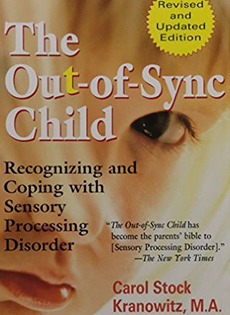What is Sensory Processing Disorder?
Sensory processing disorder (SPD) affects the way a person responds to information that comes in through the senses. A person with SPD can be oversensitive or unresponsive to sound, touch, taste, sight, and/or smell. SPD can range in severity, and in more extreme cases, can make it difficult to get through everyday tasks, including schoolwork.1
SPD is not yet recognized in the Diagnostic and Statistical Manual of Mental Disorders, but it can be identified and categorized by a certified occupational therapist with advanced training in sensory processing integration.
- 1 in 20 Children are affected by symptoms of SPD1
Early signs of sensory processing disorder
- Oversensitive to surroundings; overreacts to touch, noise, smells, etc.4
- Under sensitive to surroundings; craves roughhousing or shows high tolerance for pain4
- Fidgety, constantly in motion, can’t sit still in class4
- Lacks social skills and has trouble making or keeping friends4
- Distracted and has trouble focusing on tasks or switching to a new task4
- Struggles with writing and other motor skills4
What to Do if You Notice Signs of Sensory Processing Disorder
Take Notes
If you notice one or more of the sensory processing symptoms mentioned above, keep an eye out for others. Write down any concerning behaviors. This list will serve as an important reference when you’re talking with teachers and specialists.
Talk to Your Child’s Teacher
Schedule time with your child’s teacher to talk through these concerns. Ask whether he or she has noticed similar behaviors in your child, and whether sensory processing issues are affecting your child’s classroom performance.
Request an Evaluation
Although it is not yet recognized in the Diagnostic and Statistical Manual of Mental Disorders, SPD can be identified and categorized by a certified occupational therapist with advanced training in sensory processing integration.
Be Proactive and Trust Your Gut
You know your child better than anyone. If you notice sensory processing issues in your child, it’s up to you to seek evaluations and any necessary interventions — even if others reassure you nothing is wrong.
What to Do if Your Child is Diagnosed with Sensory Processing Disorder
Find a Specialist
An occupational therapist with advanced training in sensory processing can help your child practice strategies that produce more appropriate reactions to sensory stimulation. Some schools have occupational therapists on staff, but you can also find one through a private practice.5
Request Classroom Accommodations
Talk with your child’s teacher about making a few simple changes to help your child feel more comfortable and focused. Ask your child’s teacher or school administrator to:
- Replace fluorescent lights that buzz or flicker5
- Allow your child to have a fidget or toy that helps regulate focus and attention5
- Let your child skip overstimulating situations such as assemblies or a crowded lunchroom5
Create an Individualized Education Plan
Ask your child’s teacher about creating an Individualized Education Plan (IEP). This plan will document your child’s specific needs, necessary accommodations, and his or her progress. Take an active role in the creation of this document and ask for a written copy to take home.
Common Sensory Processing Disorder Myths
Myth:Children with SPD are not smart.
Fact:SPD and IQ are not connected. In fact, many children with SPD are intellectually gifted.3
Myth:A child with SPD will show issues with all senses: taste, touch, smell, sound, and sight.
Fact:SPD can manifest as issues with one sense, or with many senses. Some children show different sensitivities on different days. For example, one day she may overreact to sounds, and another day, sounds won’t bother her but smells will.1
Myth:SPD and ADHD are the same thing.
Fact:SPD and ADHD are different disorders with different symptoms and different treatments. Sometimes, children with SPD are misdiagnosed with ADHD.3
Myth:SPD is a form of autism.
Fact:While sensory processing issues affect some children with autism, an SPD diagnosis does not mean your child is on the autism spectrum.3
Myth:SPD is an overblown diagnosis for normal child behaviors that should be addressed through discipline.
Fact:A child who is unable to react appropriately to sensory information can have difficulty in the classroom and in life — but with the right intervention, a child with SPD can live a perfectly normal life.3
Additional Resources for Sensory Processing Disorder
Shop through AmazonSmile and Amazon will donate 0.5% of your purchase to Churchill.


The Out-of-Sync Child: Recognizing and Coping with Sensory Processing Disorders
Carol Stock Kranowitz, MA
References
- Sensory Processing Disorder Explained. SPD Foundation. Retrieved from http://www.spdfoundation.net/about-sensory-processing-disorder/
- SPD Research Collaborations. SPD Foundation. Retrieved from http://www.spdfoundation.net/research/collaborations/ben-sasson/
- Understanding Sensory Processing Issues. Understood. Retrieved from https://www.understood.org/en/learning-attention-issues/child-learning-disabilities/sensory-processing-issues/understanding-sensory-processing-issues
- Symptoms Checklist. SPD Foundation. Retrieved from http://www.spdfoundation.net/about-sensory-processing-disorder/symptoms/
- How Sensory Processing Issues Affect Kids in School. Child Mind Institute. Retrieved from http://childmind.org/article/how-sensory-processing-issues-affect-kids-in-school/